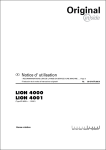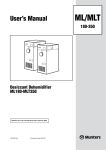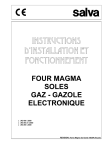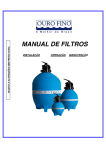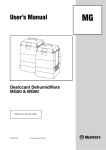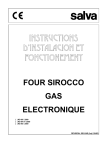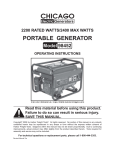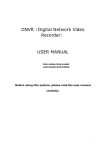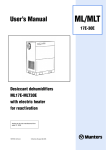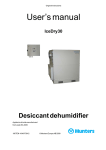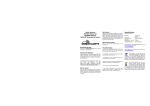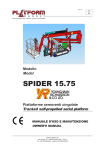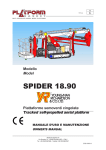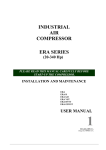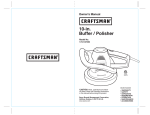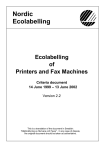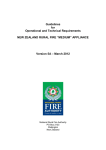Download User`s manual
Transcript
User’s manual Desiccant Dehumidifier MA-C Series Effective from serial no. 1000 190TGB-1022 © Munters Europe AB 2002 MA-C MA-Series Dehumidifiers CONTENTS 1. SUPPLIER INFORMATION 1.1 1.2 1.3 1.4 1.5 7 FAULT ISOLATION Introduction .................................................... 4 Warranty ........................................................ 4 Safety ............................................................ 4 Misuse of Equipment .................................... 4 Safety Symbols ............................................. 4 7.1 8 TECHNICAL DATA ............................................. 18 8.1 8.2 8.3 8.4 2 PRINCIPLE OF OPERATION 2.1 2.2 2.3 Product Description ....................................... 5 General .......................................................... 5 Desiccant Rotor ............................................. 5 Dimensions and Weight ........................... 19 Capacity Diagram ..................................... 20 Fan Diagrams ........................................... 21 Sound Data ............................................... 22 9 GENERAL ASSEMBLY ...................................... 24 3 PRODUCT DESCRIPTION 3.1 3.2 3.3 3.4 Fault isolation procedures ........................ 17 9.1 9.2 9.3 Construction .................................................. 6 Standard Equipment ...................................... 6 MA 2500-C, MA 3000-C, MA 10000-C ........ 6 Electrical Equipment 3.4.1 MA 2500-C Control Panel .................. 7 3.4.2 MA 3000-C Control Panel .................. 8 3.4.3 MA 10000-C Control Panel ................ 8 3.4.5 External Humidistat (option) .............. 9 3.4.6 Combistat (MA3000-C and MA10000-C) ....................................... 9 3.4.6 High Temperature Cut-Outs (HTCO) . 9 MA 2500-C Generaly Assembly .............. 25 MA 3000-C General Assembly ................ 26 MA 10000-C General Assembly .............. 28 4 INSTALATION 4.1 Delivery and Storage ..................................... 9 4.2 Moving the Dehumidifier ............................... 9 4.3 Location Requirements ................................. 9 4.4 Process and Dry Air Connections .............. 10 4.4.1 Duct for process air ......................... 10 4.4.2 Duct for rectivation air ..................... 10 4.4.3 Duct system for wet air outlet ....... 10 4.5 Electrical Connections 4.5.1 Connection to mains ........................ 11 4.5.2 External Humidistat (Option) ........... 11 5 OPERATION 5.1 5.2 5.3 5.4 Pre-start checks .......................................... 12 Check the direction of fan rotation (MA3000-C, MA10000-C) ........................... 12 Running checks 5.3.1 MA2500-C ........................................ 12 5.3.2 MA3000-C, MA10000-C ................... 13 Stopping the unit ......................................... 14 6 MAINTENNANCE 6.1 Maintenance Procedures ............................ 14 190TGB-1022-B01.12 3 Subject to change without notice MA-Series Dehumidifiers 1 SUPPLIER INFORMATION 1.1 INTRODUCTION Responsibility for Safety Every care has been taken in the design and manufacture of MA-C Series dehumidifiers to ensure that they meet the safety requirements listed in Paragraph 1.3. However, the individual operating or working on any machinery is primarily responsible for: Munters dehumidifiers provide an effective and efficient method of humidity control. MA-C series dehumidifiers are designed for process airflows of 2 500 to 15 000m3/h. 1.2 n Personal safety, safety of other personnel, and the machinery n Correct utilisation of the machinery in accordance with relevant procedures WARRANTY The warranty period is 12 months from the date of equipment commissioning. The contents of this manual include suggested best working practices and procedures. These are issued for guidance only, they do not take precedence over the above stated individual responsibility and/or local safety regulations. The warranty is limited to free replacement and shipping of any faulty part, or sub-assembly which has failed due to poor quality or manufacturing errors. All claims must be supported by evidence that the failure has occurred within the warranty period, and that the unit has been operated within the designed parameters specified. 1.4 MISUSE OF EQUIPMENT All warranty claims must specify the unit/type number and the serial number. These details are printed on the unit identification plate. Any use of the equipment other than its intended use, or operation of the equipment contrary to the relevant procedures, could cause injury to the operator, or damage to the equipment. 1.3 1.5 SAFETY Standards for Safety The following symbols are used in this document to alert the reader to areas of potential hazard. MA-C series dehumidifiers are designed and built within an EN ISO 9001 accredited design and manufacturing organisation. The units comply with the specifications of the European Machinery Directive (98/37/EEC). A WARNING is given in this document to identify a hazard which could lead to personal injury. Usually an instruction will be given, together with a brief explanation and the possible result of ignoring the instruction. The following standards are applicable to product design: n EN 60204-1, EN 292-2/A1, SAFETY SYMBOLS EN 1050, EN 292-1, EN292-2 EN50081-1, EN 50082-2, A CAUTION identifies a hazard which could lead to damage to the machine, damage to other equipment and/or environmental pollution. Usually an instruction will be given, together with a brief explanation and the possible result of ignoring the instruction. A NOTE is used to highlight additional information which may be helpful to you but where there are no special safety implications. 190TGB-1022-B01.12 4 Subject to change without notice MA-Series Dehumidifiers 2 PRINCIPLE OF OPERATION 1. Process air 3. Reactivation air 2. Dry air 4. Wet air Airflow Diagram (MA 3000-C, MA 10000-C) - Figure 1 2.1 PRODUCT DESCRIPTION 2.3 MA-C SERIES dehumidifiers are designed for dry airflows between 2 500 and 15 000m³/h. The desiccant rotor is the moisture absorbing part of the dehumidifier, and consists of a special composite matrix of heat resistant material which houses the desiccant. This design produces a compact structure which has an immense surface area for moisture absorption. The whole assembled unit is housed in a rugged protective frame work with a roof. 2.2 DESICCANT ROTOR GENERAL The rotor is divided into two sectors comprising the process sector and the reactivation sector. The air to be dehumidified (process air) is blown through the process sector of the rotor, whose structure forms narrow air flutes. The walls of the rotor are impregnated with High Performance Silica Gel (HPS) which absorbs the moisture from the air, and the resulting dry air is delivered at the dry air outlet. Simultaneously, a separate airflow (reactivation air) is heated and blown through the reactivation sector of the rotor. This heated air evaporates the moisture from the reactivation sector of the rotor. The moisture laden air (wet air) is then vented outside the humidity controlled atmosphere. Whilst this sequence is occurring, the rotor is slowly rotating (approximately 10 revolutions per hour). This rotation ensures that a new section of the rotor requiring reactivation is continuously presented to the heated reactivation sector. At the same time a new section of reactivated rotor is presented to the process air, ready to absorb moisture. The dehumidification process is therefore repeated continuously. A. Desiccant rotor B. Heater C. Drive motor 1. 2. 3. 4. Process air Dry air Reactivation air Wet air Principal of Opetation Example, Desiccant Rotor - Figure 2 190TGB-1022-B01.12 5 Subject to change without notice MA-Series Dehumidifiers 3. PRODUCT DESCRIPTION p Electrical control panel: MA-C SERIES dehumidifiers are designed for dry airflows l The electrical controls and components for the MA 2500-C unit are housed in a metal box mounted on top of the main casing. between 2 500 and 15 000m³/h. The whole assembled unit is housed in a rugged protective frame work with a roof 3.1 l The MA 3000-C and MA 10000-C electrical controls are contained in a metal case mounted within the protective framework. CONSTRUCTION The main components of the dehumidifier are: 3.2 p The rotor unit, consisting of the rotor and its driving device. p Connections to ductwork according to ISO 7807 standards. p For process air: l l G3 (EU3) filter Centrifugal fan - MA 2500-C MA 3000-C MA 10000-C p Process and reactivation air inlets are fitted with directly driven directly driven belt driven replaceable filters that can be easily changed via the inspection covers. 3.3 p For reactivation air: l l l l STANDARD EQUIPMENT G3 (EU3) filter Directly driven centrifugal fan on all models Manually operated louvred damper Electric reactivation heater MA 2500-C, MA 3000-C, MA 10000-C p All models require a three phase electrical supply. p All of the models are fitted with multi stage electric reactivation heaters. The rotor and filters are accessible for both inspection and servicing via removable inspection covers. Fabrication Number: Example : 2000/XX/XXXXX Year of Manf. Week Serial No. Identification Plate - Figure 3 190TGB-1022-B01.12 6 Subject to change without notice MA-Series Dehumidifiers 3.4 ELECTRICAL EQUIPMENT 3.4.1 MA 2500-C Control Panel 1 Item 1 2 3 4 6 5 Switch/Indicator Function Pos. 1 When the switch is in this position, the electric reactivation heater operates at 2/3 capacity. Pos. 2 When the switch is in this position, the electric reactivation heater operates at full capacity. MAN The unit is normally operated in the MAN mode. AUTO It can be used in the AUTO mode if a humidistat is used to control the dehumidifier. Power Switch (SA32) 2 Mode Switch (SA33) 3 Power Connected Lamp - MAINS (HL38) Indicates that mains power has been connected to the dehumidifier 4 Unit Running lamp - OPERATION (HL37) Indicates that the unit is running, or is ready to start on a signal from the humidisat (AUTO mode) 5 Emergency Stop Button (SB30) Operation of this button stops the unit but the Power Connected Lamp remains lit. 6 Temperature Gauge Indicates the reactivation temperature. 7 Isolator Switch (QS10) (Item not illustrated) 190TGB-1022-B01.12 Pos. 0 Pos. 1 To be used to isolate the mains supply from the unit when any form of maintenance or servicing is being carried out on the unit. 7 Subject to change without notice MA-Series Dehumidifiers 3.4.3 MA 10000-C Control Panel 3.4.2 MA 3000-C Control Panel 2 1 4 3 5 2 1 4 3 Item 1 Switch/ indicator Function Used to start and stop the dehumidifier. When the unit is switched OFF, a timer is SA31 activated, and the fans continue to run for Control switch approximately 3 mins so as to disperse the residual heat from the reactivation heater. Pos. 0 Pos. 1 Pos. 2 2 QS10 Isolator Switch Pos. 1 4 5 HL38 HL37 SB30 Emergency Stop 1 Switch/ indicator Function Used to start and stop the dehumidifier. When the unit is switched OFF, a timer is SA31 activated, and the fans continue to run for Control switch approximately 3 mins so as to disperse the residual heat from the reactivation heater. Reactivation power = 0kW Reactivation power = 52kW Reactivation power = 104kW Pos. 0 Pos. 1 Pos. 2 Pos. 3 To be used to isolate the mains supply from the unit when any form of maintenance or servicing is being carried out on the unit. Pos. 0 3 Item 2 5 QS10 Isolator Switch Switchboard disconnected from the mains. Switchboard connected to the mains. Reactivation power Reactivation power Reactivation power Reactivation power = = = = 0kW 52kW 104kW 156kW To be used to isolate the mains supply from the unit when any form of maintenance or servicing is being carried out on the unit. Pos. 0 Pos. 1 Switchboard disconnected from the mains. Switchboard connected to the mains. Power Connected Indicator: Indicates that mains power is connected to the dehumidifier 3 HL38 Unit Running Indicator: Indicates that the unit is running Power Connected Indicator: Indicates that mains power is connected to the dehumidifier 4 HL37 Unit Running Indicator: Indicates that the unit is running 5 SB30 Emergency Stop Use to stop the dehumidifier in the case of an emergency. Pressing this button disconnects all of the electrical components from the mains. The emergency stop must not be used to start and stop the dehumidifier during normal operation. Use to stop the dehumidifier in the case of an emergency. Pressing this button disconnects all of the electrical components from the mains. The doors of the cabinet must be kept closed During operation, air from the dry air fan is fed, via a filter on the side of the fan and a hose, to the cabinet in order to maintain a positive pressure in the cabinet. 190TGB-1022-B01.12 8 Subject to change without notice MA-Series Dehumidifiers 3.4.4 Humidistat MA2500-C only (OPTION) 4 INSTALLATION MA2500-C units are pre-wired so that when the units are in AUTOmatic mode they can be controlled by an externally mounted humidistat. 4.1 DELIVERY AND STORAGE To ensure consistent quality and maximum reliability, each dehumidifier is inspected before leaving the factory. If the dehumidifier is to be put into storage, prior to installation, the following precautions should be observed: 3.4.5 Combistat (MA 3000-C and MA 10000-C) The “combistat” is a combined two step thermostat and thermometer with an indicator dial placed on the side of the casing. The indicator has three different coloured dials: p The dehumidifier must be protected from physical damage. Black: Indicates the current reactivation temperature after the air heater p The dehumidifier must be stored under cover and protected from dust, frost and rain. Green: This thermostat limits the reactiviation air temperature to 140°C by switching off the last step/steps of the reactivation power. Inspection Red: Remove the transit packing and inspect the unit to ensure that no damage has occurred during transit. Any visible damage must be reported to Munters prior to installation. This thermostat limits the reactiviation air temperature to 150°C by switching off all of the reactivation power. 4.2 3.4.6 High Temperature Cut-Outs (HTCO) MOVING THE DEHUMIDIFIER Heavy load, the dehumidifier weighs in excess of 450kg. To prevent injury, or damage to the dehumidifier, always use approved equipment when attempting to move the dehumidifier. The units are fitted with two independent high temperature cut-outs (HTCO) which will stop the dehumidifier if the temperature exceeds the units design specification. These cut-outs can be manually reset by pressing the appropriate buttons located inside the control panel for the MA2500-C and on the side of the heater for both the MA3000 and 10000-C units. In order to facilitate the movement and transportation of the dehumidifier, it is housed within a framework that is fitted with lifiting eyes. In addition the frame also has built in lifting points for fork trucks to use. 4.3 LOCATION REQUIREMENTS To achieve optimum performance and trouble-free service, it is essential that the proposed installation site meets with the location and space requirements for the model being installed. For dimensions, weight and space requirements, including service access details, refer to Technical Specification. 190TGB-1022-B01.12 9 Subject to change without notice MA-Series Dehumidifiers 4.4 PROCESS & DRY AIR CONNECTIONS 4.4.2 Duct for Reactivation Air The process and reactivation air ducts are sized in accordance with ISO 7807 recommendations. The duct connections contain tapped inserts for M8 bolt fixings. If the dew-point of the reactivation air is higher than the ambient temperature of the dehumidifier, then the process air procedure should be used for the reactiviation air. When installing ductwork the following recommendations should be observed 4.4.3 Duct System for Wet Air Outlet Wet air ductwork should be manufactured in corrosion resistant material and should be capable of withstanding temperatures of up to 100°C. The dehumidifier has been designed to operate at specific process airflows (corresponding to the fan sizes installed) and must not be directly connected to air-conditioning systems. Due to the high moisture content of the air in the wet air outlet ducting, condensation will readily form on the duct walls. Horizontal duct-runs should therefore be installed sloping downwards (away from the dehumidifier) to allow for condensate drainage. In addition, Ø 10 mm drain holes should be drilled at the low points in the duct to prevent water accumulating in the duct. p The length of ductwork should be kept as short as possible to minimise static air pressure losses. p Horizontal (reactivation) duct-runs should be installed sloping downwards (away from the dehumidifier) to allow for condensate drainage. On the wet air outlet ducting, suitable condensate drains should be installed at low points in the ductwork. If this is impossible, a rising wet air duct may be used under the following circumstances: p Ducts mounted directly onto the dehumidifier should be adequately supported to minimise the load and stress due to the duct weight and movement. p The duct is insulated (25 mm mineral wool or equivalent) p Ensure that access for operation and servicing is not restricted when designing and installing ducting. p The ducts are drained at their lowest points via Ø 10 mm drainage holes p To reduce noise and/or vibration being transmitted along rigid ductwork, good quality, airtight flexible connections should be fitted. The ducting must always be insulated, using 25mm of mineral wool or equivalent if there is a risk of freezing. p Dampers for balancing the airflows must be installed in the dry air outlet. The correct airflow is essential for maintaining the operating efficiency of the unit. If the dehumidifier is to be connected to a duct system, the procedure should be as follows. 4.4.1 Duct for process air If the dew-point of the process air is higher than the ambient temperature of the dehumidifier, there is a risk of condensation in the duct. Ducts can be installed in two ways: 1. The duct is mounted sloping down and away from the dehumidifier so that any condensate formed can drain away. 2. If any duct does slope upwards, it should be provided with drainage holes (Ø 10 mm) at the lowest point so as to prevent any condensate entering the dehumidifier and damaging the rotor. There is a Ø 10 mm drainage hole in the bottom of the filter unit to prevent any condensate accumulating in the filter unit. 190TGB-1022-B01.12 10 Subject to change without notice MA-Series Dehumidifiers 4.5 ELECTRICAL CONNECTIONS 4.5.2 Humidistat - MA2500-C only (option) 4.5.1 Connection to the Mains MA2500-C units are pre-wired so that when the units are in AUTOmatic mode they can be controlled by an externally mounted humidistat. The humidistat is connected to the terminal block on the switchboard as shown on the circuit diagrams. On delivery these terminal are shortcircuited. WARNING: THIS APPLIANCE MUST BE EARTHED Electrical connections should be made by qualified persons only and in accordance with local electricity regulations. Location requirements When an external humidistat is installed, it should be sited in accordance with the following guidelines: MA-C dehumidifiers are supplied complete with all the internal wiring installed and configured in accordance with the specified voltage and frequency as detailed on the identification plate. p The humidistat should be located at least 1 to 1,5m above the floor level so that it can sense a representative level of relative humidity in the room to be controlled. The dehumidifier must never be operated on a voltage or frequency other than that for which it was designed and manufactured. p The humidistat should be mounted in a position where it will not be directly subjected to the influence of either dry or moist air (avoid draughts from opening doorways etc). p The humidistat should not be located close to heatproducing equipment, or exposed to direct sunlight, since changes in temperature will have a direct effect on the relative humidity. All of the units are designed for 3-phase AC operation: 380V 3~ 50Hz 400V 3~ 50Hz 440V 3~ 60Hz Electrical Specification Refer to the wiring diagrams, that are despatched with the unit, and connect the supply to the terminals L1, L2 and L3, which are located in the control panel. p The humidistat connecting cable should have a conductor cross-sectional area of not less than 0,75mm² and must have an insulation resistance rating in excess of 500V ac. Before connecting the unit to the mains supply, the three phases of the power supply should be checked to ensure that the supply voltage does not vary by more than 10% of the specified operating voltage. This is particularly important where large loads (caused by switching of ancillary equipment) could cause voltage fluctuations. p The humidistat must be designed so that the contacts close on a rising RH set-point to complete the control circuit and start the dehumidifier. The unit must be adequately earthed and equipped with a fused isolator to enable isolation of the electrical power for inspection and servicing. The isolator should be installed within easy reach of the dehumidifier control panel. The current rating of the fused isolator must be in accordance with the type and model of dehumidifier being installed. For details refer to Technical Specification. All screws in the control panel must be retightened, BEFORE connecting the unit to the mains for the first time. The power supply cables must be of the correct size and current rating for the dehumidifier being installed. For details refer to Technical Specification. 190TGB-1022-B01.12 11 Subject to change without notice MA-Series Dehumidifiers 5 OPERATION 5.3 5.1 PRE-START CHECKS If the dehumidifier fails any of the following checks refer to Fault Isolation (Paragraph 7.1) for actions required to identify the probable cause of the fault, and the corrective action required to return the unit to service. Before starting the dehumidifier ensure that the mains power supply is isolated from the dehumidifier and carry out the following checks: RUNNING CHECKS To prevent damage to the fans, the unit must not be run for longer than 10 minutes prior to setting up the process and reactivation airflows. For details refer to Paragraphs 5.3.1 and 5.3.2 1. Make sure that the all of the air inlets and outlets are not blocked. 2. Carry-out a visual check on all ductwork, and duct insulation, for correct connection and for signs of damage. 5.3.1 MA 2500-C 3. Check that the incoming power supply cables have been correctly installed. 1. Set the reactivation air adjustment damper to the fully open position. 4. If a humidistat has been installed, check that it has been correctly positioned and has been correctly connected to the unit. For details refer to the Installation (Paragraph 4.5.2) and the circuit diagrams supplied with the unit. 2. Set the process air adjustment damper, if fitted, half open. (A damper, if fitted, should be installed in the dry air duct) 5.2 3. Set the mode switch to the MAN position. 4. Start the dehumidifier by turning the POWER switch to position 2. CHECK THE DIRECTION OF FAN ROTATION (MA 3000-C, MA 10000-C) MA 3000-C 1. Turn the main switch to position 1 QS10 5. Ensure that the rotor is rotating smoothly, at approximately 8 r.p.h, in the direction of the red arrow (upwards as viewed through the inspection hole located on the front panel) MA 10000-C QS10 MA 2500-C Air flow adjustment 2. Start the unit by turning the control switch to position 1 SA31 SA31 3. Wait a few seconds and then set the control switch to position 0 SA31 SA31 4. Immediately stop the unit by setting the main switch to position 0 Failure to correctly adjust the process and reactivation air flows could cause the unit to malfunction. QS10 QS10 5. Check that the fans are rotating in the direction of the arrow on the fan casing 1. Using the dampers installed, adjust the process and reactivation airflows to the corrected rated flow. - - To achieve the design performance, the air flow dampers must be correctly adjusted in accordance with the rated airflow detailed in the Technical Specification (Paragraph 8) 2. Allow the unit to run for a few minutes to ensure that the operating conditions have stabilised. 6. If the fans are rotating in the wrong direction, wait until the fans have stopped completely and then change the rotation by switching cables L1 & L2 around. 190TGB-1022-B01.12 3. Ensure that the indication on the reactivation temperature gauge falls within the parameters shown in the diagram on page 13. If the temperature is too low, close the reactivation damper in small stages (allowing the temperature indication to stabilise each time) until the temperature indication lies within the specification. 12 Subject to change without notice MA-Series Dehumidifiers MA 3000-C, MA10000-C Air flow adjustment 5.3.2 MA 3000-C, MA 10000-C MA 3000-C 1. Set the main switch to position 1. QS10 To achieve the design performance, the air flow dampers must be correctly adjusted in accordance with the rated airflow detailed in the Technical Specification (Paragraph 8) MA 10000-C QS10 2. Set the control switch to 1 and allow 5 secs. for the fans to reach their operating speed. SA31 SA31 3. Set the control switch to position 2 SA31 SA31 4. MA 10000-C: Set control switch to position 3 _ SA31 Failure to correctly adjust the process and reactivation air flows could cause the unit to malfunction. 1. Using the damper installed in the reactiviation air inlet duct (and dry air outlet if fitted), adjust the airflows to the corrected rated flow. 2. Allow the unit to run for a few minutes to ensure that the operating conditions have stabilised. 5. Carry out the airflow adjustment 3. Ensure that the indication on the reactivation temperature gauge (black dial) falls within the parameters shown in the diagram below. MA 2500-C Reactivation Temperature If the temperature is too low, close the reactivation damper in small stages (allowing the temperature indication to stabilise each time) until the temperature indication lies within the specification. MA 10000-C Reactivation Temperature MA 3000-C Reactivation Temperature Symbols: ti = Inlet air temperature tu = Reactivation air temperature (°C) (°C) Example for MA10000-C: Inlet air temperature (ti) = Reactivation air temperature = Temperature increase = 190TGB-1022-B01.12 13 15°C 110°C 95°C Subject to change without notice MA-Series Dehumidifiers Automatic mode (MA2500-C only) 6 For the unit to operate in the AUTOMATIC mode a humidistat must be installed correctly to the unit. For details refer to paragraph 4.5.2. The dehumidifier contains lethal voltages. Ensure that the unit is isolated from the mains supply before attempting to carry out any maintenance work. 1. Set the mode switch SA33 to the AUTO position. 2. Adjust the humidistat set point for the minimum relative humidity (RH) value. Apply power to the unit as detailed in paragraph 5.3.1 operations 1, 2,3, 4 and 5 for the MA 2500-C and 5.3.2 for the MA 3000-C and 10000-C. Ensure that the unit is operating. The dehumidifier contains areas of high temperature. The unit and the surrounding ductwork must be allowed to cool down prior to maintenance work being carried out. Adjustments, maintenance and repairs should only be carried out by qualified personnel who are aware of the hazards of maintaining equipment containing high voltages and temperatures. 3. Slowly increase the humidistat set point and check that the unit switches Off when the set point matches the RH in the area where the humidisat is located. 4. Slowly decrease the humidistat set point and check that the unit switches on when the set point falls below the RH in the area where the humidistat is located. 6.1 6. Calibrate the humidistat in accordance with the manufacturer’s recommendations. The frequency of maintenance will be determined by the operating conditions and the quality of the environment where the unit is being used. If the process air has a high dust-loading the scheduled maintenance should be carried out at at more frequent intervals. This can best be determined by your local Munters Service Engineer. 7. Reset the humidisat to the desired set point. STOPPING THE UNIT To turn the units off under normal operating conditions: MA 2500-C: Set the power switch SA32 to 0 MA 3000-C: Set the control switch SA31 to 0 MA 10000-C: Set the control switch SA31 to 0 MAINTENANCE PROCEDURES MA-C dehumidifiers are designed to run for long periods with the minimum of attention and will normally require very little maintenance. 5. Switch off the power to the unit. 5.4 MAINTENANCE However, in order to maintain reliable peformance and prolong the service life of vital components, regular scheduled maintenance is recommended. Recommendations for perodic maintenance are given on pages 15 and 16 of this manual. Ensure that after apprximately 3 minutes the fans have stopped. In order to dissipate any residual heat, the reactivation air fan, process fan and drive motor will continue to run (after the unit has been switched off). In an emergency situation Use the EMERGENCY STOP! 190TGB-1022-B01.12 14 Subject to change without notice MA-Series Dehumidifiers MA 2500-C PERIODIC MAINTENANCE Inspection/Maintenance Procedure Component 3-6 Months 12 Months Process and reactivation air filters¹ Clean the filter housing and change the filter if dirty. If the operating conditions and/or the condition of the process air has, for example, a high dust loading, then the filter may require changing more frequently. Clean the filter housing and change the filter if dirty. If the operating conditions and/or the condition of the process air has, for example, a high dust loading, then the filter may require changing more frequently. General assembly/housing Check for signs of physical damage and clean the inside and outside of the unit as required. Check for signs of physical damage and clean the inside and outside of the unit as required. Process and reactivation air fans Check for signs of physical damage and clean the motor casings as required. All dust and dirt in the motor cooling slots must be removed. Check the electrical connections to the motors to ensure that they are not loose. Check for signs of dammage and overheating. Rotor drive assembly Check the drive belt for signs of damage and ensure the tension is correct. (see diagram below) If the belt needs adjusting, remove the belt connector, shorten the belt and re-connect. Check the electrical connections to the motors to ensure that they are not loose. Check for signs of dammage and overheating. Check the drive belt for signs of damage and ensure the tension is correct. (see diagram below) If the belt needs adjusting, remove the belt connector, shorten the belt and re-connect. Electrical control panel and wiring Reactivation heater Inspect the components and wiring in the electrical control panel for signs of dammage and overheating. Inspect the components and wiring in the electrical control panel for signs of dammage and overheating. Check that none of the electrical connections have worked loose. Check that none of the electrical connections have worked loose. Check that none of the electrical connections have worked loose Remove any scale deposits or dirt from the bottom of the heater compartment. Check that none of the electrical connections have worked loose. Seals Check the location and wear of the seals and replace any worn or ill fitting ones. Ensure that the seal just touches the rotor face and that the rotor rotates smoothly. Check the location and wear of the seals and replace any worn or ill fitting ones. Ensure that the seal just touches the rotor face and that the rotor rotates smoothly. Humidistat (if fitted) Check the calibration and adjust if necessary. Check the calibration and adjust if necessary. All components Check all of the functions of the unit. Check all of the functions of the unit. Replace any defective or worn components if necessary. Replace any defective or worn components if necessary. In order to maintain efficient dehumidification, a full capacity check should be carried out by a Munters Service Engineer. ¹ In order to prevent dust and/or pigment particles accumulating in the rotor, which will damage the rotor, the dehumidifier must NEVER be operated without all of the filters being fitted. Rotor Drive Belt Tension This diagram shows that the rotor drive motor belt tension must equal to or greater than 20 mm in order to comply with the required specification. 190TGB-1022-B01.12 15 Subject to change without notice MA-Series Dehumidifiers MA 3000-C AND MA 10000-C PERIODIC MAINTENANCE Interval/Steps to be taken Description Every day Cleaning of filters¹ Take out the filter cells and remove the dust from the filter material by shaking/beating it lightly. Checking the rotation of the rotor Remove one of the plastic plugs in the rotor casing and check, whilst the unit is operating, that the rotor is rotating correctly. Every week Filter replacement Clean the filter housing and change the filter. If the operating conditions and the condition of the air being processed has for example a high dust loading, then the filter may require changing more frequently. Make sure that the white side of the filter faces towards the dehumidifier. Every 3 months Check the rotor drive belt tension Remove the inspection cover from the rotor casing and check the belt tension of the rotor drive. The tension is correct if dimension "a" is greater than 2-3 cm. If the belt needs adjusting, remove the belt connector, shorten the belt and re-connect. MA 10000-C Check the dry air fan belt tension If the belt needs adjusting, remove the belt connector, shorten the belt and re-connect. Every 6 months Replace the switchboard filter Remove the hose and filter housing from the dry air fan, remove the old filter cartridge, clean the filter housing and fit a new filter. MA 10000-C Dry air fan and motor Lubricate Every 12 months Rotor belt tensioner Remove the inspection cover in the rotor casing and lubricate all of the joints in the belt tensioner. ¹ In order to prevent dust and/or pigment particles accumulating in the rotor, which will damage the rotor, the dehumidifier must NEVER be operated without all of the filters being fitted. 190TGB-1022-B01.12 16 Subject to change without notice MA-Series Dehumidifiers 7 FAULT ISOLATION Adjustments, maintenance and repairs should only be carried out by qualified personnel who are aware of the hazards of maintaining equipment containing high voltages and temperatures. The purpose of this section is to assist the operator in recognising and rectifying faults in the unit. The dehumidifier contains lethal voltages. Ensure that the unit is isolated from the mains supply before attempting to carry out any maintenance work. 7.1 FAULT ISOLATION PROCEDURES When a fault occurs the following fault isolation checklist should be carried out before calling a service technician. This will assist in identifying faults that can be easily rectified by the operator. The dehumidifier contains areas of high temperature. The unit and the surrounding ductwork must be allowed to cool down prior to maintenance work being carried out. Fault Isolation checklist for MA2500-C, MA3000-C, MA10000-C Fault Symptom Unit stopped. (All indicators are off) Unit stopped (Power connected indicator on, unit running indicator on) Probable Fault Corrective Action Power supply failure. Check the power supply to the unit. Mains fuse has ruptured. Replace the fuse. Manual mode: Unit inadvertently switched into AUTOmatic mode without a humidistat being connected. Switch the dehumidifier into MANual mode and check that the unit starts. Automatic mode (MA2500-C only): Unit stopped. (Power connected indicator on, unit running indicator off) Loss of performance. (The dehumidifier appears to be operating correctly - but is not controlling the humidity) 190TGB-1022-B01.12 Humidistat fault (AUTOmatic mode). Check the operation and calibration of the humidistat inaccordance with the manufacturer’s recommendations. The high temperature cut-out (HTCO) has tripped. Check the filters, fan impellers, air inlet and air outlet ducts are free from obstructions and are not clogged with dirt. Reset the cut-out when the unit has cooled down. One of the motor overload circuit breakers has trripped. Investigate the cause of the fault and rectify. Reset the breaker. Heating capacity is too low. Check the operation of the heater. Reactivation and process airflows are not in accordance with the design specification. Measure and adjust the reactivation airflows. For details refer to Operation (paragraphs 5.3.1 and 5.3.2. Rotor drive failure. Check the rotor drive belt and drive motor. Humidistat not functioning correctly. (AUTOmatic mode) Check the operation and calibration of the humidistat inaccordance with the manufacturer’s recommendations. 17 Subject to change without notice MA-Series Dehumidifiers 8 TECHNICAL DATA Model MA 2500 C MA 3000 C MA 10000 C 0,69 2 500 300 50 3,0 1,39 5 000 880 40 7,5 4,17 15 000 590 30 18,5 0,23 830 800 40 1,5 0,46 1670 390 35 2,2 1,39 5000 540 35 7,5 31,5 51,0 48,5 43,9 57,7 92,0 87,5 82,4 183,5 287,0 272,5 257,4 27,0 48,0 157,5 18 G3 (EU3) IP44 35 G3 (EU3) IP44 35 G3 (EU3) IP44 PROCESS AIR ¹ Rated Airflow (m³/s) Rated Airflow (m³/h) Total Pressure Available (Pa) Pressure drop (Pa)² Fan Motor Power (kW) REACTIVATION AIR ¹ Rated Airflow (m³/s) Rated Airflow (m³/h) Total Pressure Available (Pa) Pressure drop over a clean filter (Pa) Fan Motor Power (kW) ELECTRICAL POWER AND RATED CURRENT Total Power (kW) Rated Current 3 ~ 50Hz 380V Rated Current 3 ~ 50Hz 400V Rated Current 3 ~ 60Hz 440V REACTIVATION HEATER Reactivation Heater Power (kW) MISCELLANEOUS DATA Drive Motor Power (W) Air Filtration (Standard) Dust and Water Resistance (Main Case) ¹ Figures quoted are nominal, based on fan air inlet temperature of 20°C, and an air density of 1.2kg/m³ 190TGB-1022-B01.12 18 Subject to change without notice MA-Series Dehumidifiers 8.1 DIMENSIONS AND WEIGHT 1 Process air 3 Reactivation air 2 Dry air 4 Wet air MA 2500-C MODEL A B C D E F G H J K L M N O P WEIGHT (kg) MA 2500-C 100 300 290 470 100 300 520 240 250 80 550 2350 900 1200 800 450 N MA 3000-C, MA 10000-C A B C D E F G H J K L M MA 3000-C 250 315 410 800 200 250 305 910 300 106 800 2450 1215 1370 890 MA 10000-C 400 500 690 1160 250 315 470 1460 300 106 900 3750 1830 2060 2070 190TGB-1022-B01.12 19 O WEIGHT (kg) MODEL Subject to change without notice MA-Series Dehumidifiers 8.2 CAPACITY DIAGRAM If dry air conditions below 1 g/kg are required, please consult Munters. SYMBOLS xi ti xu ∆t = Moisture content of process air g/kg = Process air temperature °C = Moisture content of Dry air g/kg = Dry air temperature rise °C Sample Calculation for dehumidifier type MA: 190TGB-1022-B01.12 20 Process air moisture content xi = 12.0g/kg Process air temperature ti = 20°C Dry air moisture content xu = 6.0g/kg Dry air temperature rise ∆t = 22°C Total Dry Air Temperature tu = 20 + 22 = 42°C Subject to change without notice MA-Series Dehumidifiers 8.3 FAN DIAGRAM The fan diagrams are for inlet conditions of 20°C, density 1,2kg/m2 1 PROCESS AIR q 2 REACTIVATION AIR P t = Total pressure available Pa = Airflow m3/s (m3/h) MA 2500-C MA 10000-C MA 3000-C 190TGB-1022-B01.12 21 Subject to change without notice MA-Series Dehumidifiers 8.4 SOUND DATA NOISE PATH MODEL L wt dB CORRECTION OF K ok dB AT ISO-BAND No./CENTRE FREQUENCY (Hz) 1/63 2/125 3/250 4/500 5/1000 6/2000 7/4000 8/8000 MA 2500-C A B C 96 97 88 -33 -27 -19 -22 -16 -9 -10 -9 -3 -6 -6 -9 -6 -6 -9 -5 -5 -11 -12 -13 -16 -27 -17 -19 MA 3000-C A B C 103 104 93 -6 -6 -7 -6 -6 -9 -6 -6 -5 -7 -9 -6 -14 -13 -14 -21 -17 -17 -27 -22 -22 -35 -30 -29 MA 10000-C A B C 107 108 97 -8 -6 -7 -5 -6 -9 -5 -6 -5 -8 -9 -6 -14 -13 -14 -20 -17 -17 -27 -22 -22 -33 -30 -29 A B C NOISE PATHS TO SURROUNDINGS: A = Noise path to duct system. B = Noise path to the surroundings, dry air duct length 1 m. C = Noise path to the surroundings, duct connected. SYMBOLS: Lwt = Total noise level dB (rel 10-12W) Lw = Noise power level in octave band dB (rel 10-12W) Kok = Correction for the calculation of Lw Lw = Lwt + Kok 190TGB-1022-B01.12 22 Subject to change without notice MA-Series Dehumidifiers 190TGB-1022-B01.12 23 Subject to change without notice MA-Series Dehumidifiers 9. GENERAL ASSEMBLY Spare and replacement parts should be ordered from your local sales company. For addresses and telephone numbers refer to the back page. When ordering spare parts always supply the following details: n Type (refer to identification plate on unit) n Fabrication number (refer to identification plate on unit) n Electrical specification (refer to identification plate on unit) n Description of spare part required n Quantity required ORDER EXAMPLE: T ype ............................................ MA 3000-C Fabrication Number .................. 96/X/30/1411 Electrical Specification ........... 3 ~ 380V 50Hz Description ....................... Process Fan Motor Quantity Required ........................................ 1 190TGB-1022-B01.12 24 Subject to change without notice MA-Series Dehumidifiers 9.1 MA 2500-C GENERAL ASSEMBLY Item Description Item Description 1 Casing 7 Process Fan Assembly 2 Rotor 8 Damper 3 Seal Assembly 9 Heater 4 Drive Assembly 10 Control Panel 5 Thermostat Bulb 11 Thermometer 6 Reactivation Fan Assembly 12 Process Filter 190TGB-1022-B01.12 25 Subject to change without notice MA-Series Dehumidifiers 9.2 MA 3000-C GENERAL ASSEMBLY 190TGB-1022-B01.12 26 Subject to change without notice MA-Series Dehumidifiers MA 3000-C GENERAL ASSEMBLY Item Description Item Description 1 Flange - Reactivation 2 Reactivation Filter 18 Rotor 3 Damper 19 Drive Motor 4 Electric Heater 20 Pulley 5 Heating Elements 21 Drive Belt Connector 6 Thermostat ATHF 22 Drive Belt 7 Silicon Seal 8 Reactivation Seal 23 Process Air Connecting Piece 9 Process Seal 24 Process Air Connecting Piece 10 Combistat 11 Reactivation Connecting Duct 25 Impeller 12 Flange - Process 26 Fan motor 13 Process Filter 27 Filter 14 Connecting Piece 28 Fixing knob ROTOR ASSEMBLY PROCESS FAN ASSEMBLY REACTIVATION FAN ASSEMBLY 15 Impeller 16 Fan motor 17 Anti vibration dampers 190TGB-1022-B01.12 27 Subject to change without notice MA-Series Dehumidifiers 9.3 MA 10000-C GENERAL ASSEMBLY 190TGB-1022-B01.12 28 Subject to change without notice MA-Series Dehumidifiers MA 10000-C GENERAL ASSEMBLY Item Description Item Description 1 Flange - Reactivation 2 Reactivation Filter 18 Rotor 3 Damper 19 Drive Motor 4 Electric Heater 20 Pulley 5 Heating Elements 21 Drive Belt Connector 6 Thermostat ATHF 22 Drive Belt 7 Silicon Seal 8 Reactivation Seal 23 Process Air Connecting Piece 9 Process Seal 24 Process Air Connecting Piece 10 Combistat 11 Reactivation Connecting Duct 25 Impeller 12 Flange - Process 26 Fan motor 13 Process Filter 27 Filter 14 Connecting Piece 28 Fan Pulley 29 Motor Pulley ROTOR ASSEMBLY PROCESS FAN ASSEMBLY REACTIVATION FAN ASSEMBLY 15 Impeller 30 Drive Belt 16 Fan motor 31 Fixing knob 17 Anti vibration dampers 190TGB-1022-B01.12 29 Subject to change without notice ARGENTINA Munters Argentina BUENOS AIRES Tel: +54 (0)11 4902 1874 Fax: +54 (0)11 4902 1823 CANADA Munters Inc. MISSISSAUGA Tel: +1 905 858 5851 Fax: +1 905 858 9130 GERMANY Munters GmbH HAMBURG Tel: +49 (0)40 7 341 601 Fax: +49 (0)40 7 341 6131 NEW ZEALAND Munters Pty Ltd AUCKLAND Tel: +64 96 34 8241 Fax: +64 96 34 8237 SINGAPORE Munters Pte Ltd SINGAPORE Tel: +65 744 6828 Fax: +65 744 9585 THAILAND Munters Co., Ltd BANGKOK Tel: +662 645 2708 Fax: +662 645 2710 AUSTRALIA Munters Pty NORTH ALBURY Tel: +61 (0) 260 256 422 Fax: +61 (0) 260 258 266 CHINA Munters Beijing Ltd BEIJING Tel: +86 (0)10 6942 9512 Fax: +86 (0)10 6942 9513 ITALY Munters S.R.L. ASSAGO (MI) Tel: +39 0 2 488 6781 Fax: +39 0 2 488 1171 NORWAY Munters Norge A/S OSLO Tel: +47 2316 5230 Fax: +47 2229 3644 SOUTH AFRICA Munters (Pty) Ltd JOHANNESBURG Tel: +27 (0)11 455 2550/1/2 Fax: +27 (0)11 455 2553 UNITED KINGDOM Munters UK Ltd HUNTINGDON Tel: +44 (0) 1480 432 243 AUSTRIA Munters Luftentfeuchtung WIEN Tel: +43 (0) 1 616 42 98 Fax: +43 (0) 1 616 42 98 98 DENMARK Munters A/S FARUM Tel: +45 44 95 3355 Fax: +45 44 95 3955 JAPAN Munters KK TOKYO 174 Tel: +81 (0)3 5970 0021 Fax: +81 (0)3 5970 3197 NETHERLANDS Munters Vochtbeheersing ALPHEN a/d RIJN Tel: +31 (0) 172 43 32 31 Fax: +31 (0) 172 44 29 60 SPAIN Munters Spain SA MADRID Tel: +34 (9) 1 640 0902 Fax: +34 (9) 1 640 1132 USA Munters Corporation AMESBURY Tel: +1 978 241 1100 Fax: +1 978 241 1214 BELGIUM Munters N.V. AARTSELAAR Tel: +32 (0) 3 458 2434 Fax: +32 (0) 3 458 2433 FINLAND Munters OY HELSINGFORS Tel: +358 (0)9 8386 0330 Fax: +358 (0)9 8386 0336 KOREA Munters SEOUL Tel: +82 (0)2 552 8770 Fax: +82 (0)2 552 8772 POLAND Munters Poland Sp zoo GDANSK Tel: +48 58 305 35 17 Fax: +48 58 346 34 53 SWEDEN Munters Europe AB SOLLENTUNA Tel: +46 (0)8 626 6300 Fax: +46 (0)8 754 8594 www.munters.com BRAZIL Munters Brasil VILA EMILIANO PERNETA Tel: +55 (0)41 868 2176 Fax: +55 (0)41 868 2105 FRANCE Munters France S.A. COLOMBES PRINCIPAL CEDEX Tel: +33 (0) 141 19 24 42 Fax: +33 (0) 141 19 00 32 MEXICO Munters de Mexico S.A. de C.V. GUADALUPE N.L. Tel: +52 (9) 8 327 5990 to 93 Fax: +52 (9) 8 327 5994 SAUDI ARABIA Hawa Munters RIYADH Tel: +966 (1)477 1514 Fax: +966 (1)476 0936 SWITZERLAND Munters AG ZÜRICH Tel: +41 (0) 1 271 1013 Fax: +41 (0) 1 271 1019 Fax: +44 (0) 1480 413 147

































